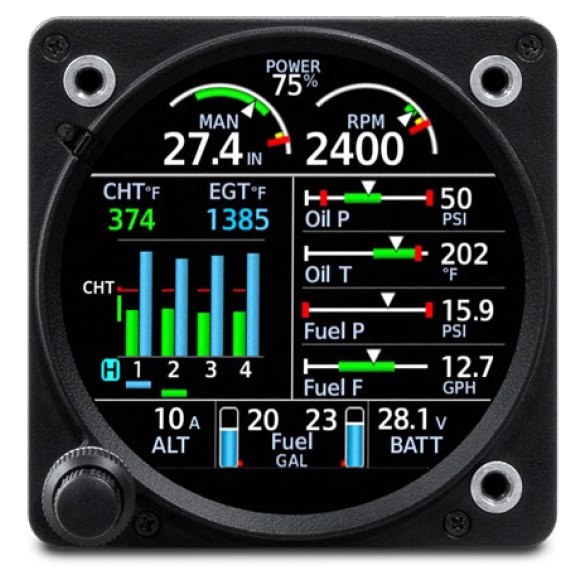Garmin Announces New Software for GI 275 Expected in August

Garmin is pleased to announce an update to the GI 275 engine indication system (EIS) that includes enhanced display layouts that optimize display space and show more engine data on a single page, ultimately helping pilots quickly view essential engine, fuel and electrical data. In addition, improved graphical information and gauges are used to help pilots dynamically visualize sensor data and accurately assess the aircraft’s engine performance. As an alternative to the dual-concentric knob, the intuitive touchscreen user interface now features page shortcuts that allow the pilot to switch pages with just a single touch of the display. Other enhancements include a new Flight Summary Page, Engine Percent Power display, EIS page shortcuts, user customizable EIS fields and more.
Improved EIS page layouts and capabilities
A new bar graph on the main EIS page displays EGT and CHT for individual cylinders. For quicker and easier interpretation of engine data, font sizes of select EIS values have been increased. In addition, a new combined EGT/CHT page brings these indications into a single page for simplified monitoring, plus Normalized Mode, which allows users to easily monitor engine temperature fluctuations while in cruise mode, and turbine inlet temperature (TIT) lean functionality for appropriately equipped aircraft. Additional new features include improved fuel tank bar gauges and the ability to display Engine Percent Power at the top of the screen. Please note that engine percent power cannot be displayed in Cirrus aircraft.

New Flight Summary Page
A new Flight Summary page contains pertinent aircraft timers such as flight hours, hobbs time, and tach time on a dedicated screen instead of in a menu, Other additions to the flight summary page include maximum RPM and temperature limitations for the engine, as well as fuel and lean data that is dynamically updated throughout the flight for real-time analysis in the air, along with a comprehensive post-flight review of engine data on the ground.
EIS Page Shortcuts and Customizable Fields
Shortcuts have been added with increased touch functionality to enable pilots to quickly access more detail with regard to specific EIS data. With a single touch of the EGT/CHT indications on the main page, the GI 275 EIS quickly switches to the dedicated EGT/CHT page. To more easily access fuel calculations, pilots can touch the fuel gauge from the main page to switch to the fuel computer page. In addition, pilots can touch the RPM area on any page to return to the main page. Pilots also have the ability to customize the AUX page EIS fields relevant to their flight with user selectable buttons access via the touch screen.
Wireless EIS Data Logging and Streaming
Pilots can stream and view EIS data in real-time on the Garmin Pilot™ App, with the data later uploaded automatically to flyGarmin.com for storage and further review. This seamless integration allows owners and operators to get the most out of their aircraft and engine investment by easily reviewing real-time and historical engine data performance at any time.
Additional Updates: Changes to ADI Restrictions and More
In addition to the large number of upgrades to the EIS functionality, the popular customer request for GI 275 to be used as an MFD when integrated with a TXi (software version 3.30 or later) and GFC 500 is now available. Previously required to be locked as an ADI only when installed as a standby when a GFC 500 is present, with software version 2.40 customers can take advantage of a full array of MFD features on the GI 275 with a TXi, GFC 500, and standby GI 275 installation.
The GTP 59 can now be interfaced with the GEA 24 when installed with EIS only units to provide Outside Air Temperature information on the EIS display. These new GI 275 EIS improvements are expected to be available via software version 2.4 in August. Please contact our Sales Department with any questions or to request a quote for a new installation.

4 years ago

